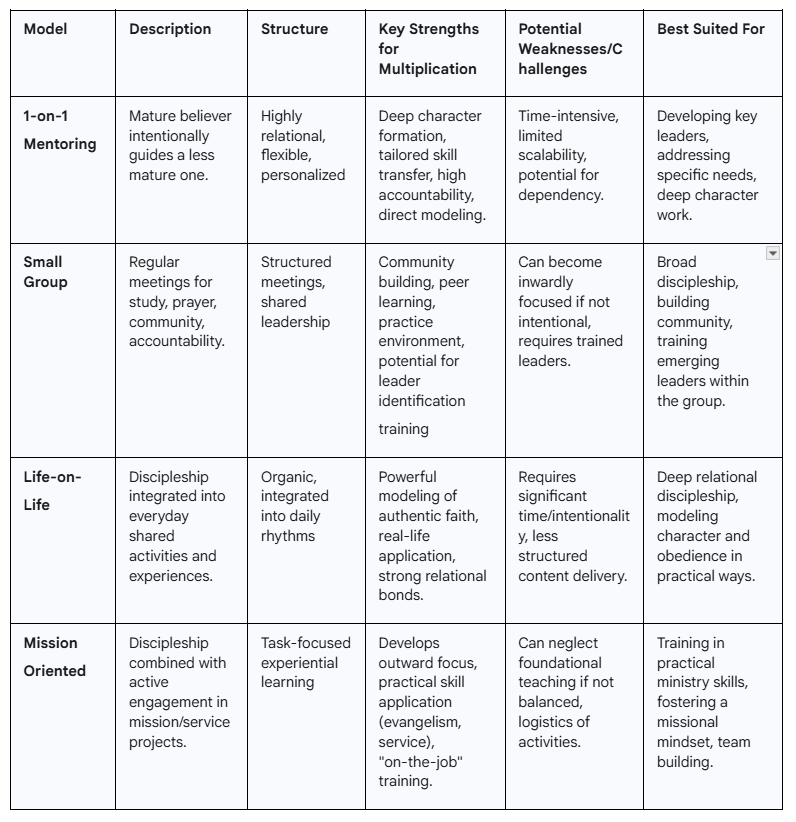Hey Peeps! So, we know we need to equip disciples with character and skills to become Disciple-makers. But how does that actually happen? What are some of the ways churches and ministries get this important training done? Let’s take a look!
Overview of Discipleship Models
It’s pretty clear that disciples need intentional training to become effective disciple-makers. To do this, each church or movement has its own way of doing things, its own strategies and strengths. Some common ones are:
One-on-One Discipleship: This is where a more mature believer intentionally mentors someone younger in their faith journey.
Small Group Discipleship: Groups get together regularly for Bible study, prayer, hanging out and keeping each other accountable.
Classroom or Seminar-Based Discipleship: Think structured teaching sessions on specific topics or books of the Bible.
Life-on-Life Discipleship: This is where discipleship gets woven into everyday shared life and activities.
Peer Discipleship: Believers who are at a similar stage in their faith journey help each other grow.
Digital Discipleship: Using online tools and platforms for mentoring, study and building community.
Programmatic Discipleship: These are structured programs with clear steps and milestones to work through.
Family-Based Discipleship: Equipping parents to disciple their own kids at home.
Mission-Oriented Discipleship: Discipleship happens while everyone’s involved in shared mission and service activities.
No single model is the best or works for everyone. The most effective strategy for your church may involve mixing and matching elements from different models or focusing on a model your church can really do well. The goal is to be consistent and clear, based on your own situation, resources and targets. The specific structure isn’t as important as intentional disciple-making in action.
Key Models for Developing Multiplying Disciple Makers
While lots of these models help with spiritual growth, some seem especially good for our goal of developing multiplying disciple makers:
One-on-One/Mentoring: This model is fantastic for giving personalised guidance, building deep relational connections, and developing skills in a tailored way. It’s a perfect setting for modelling specific disciple-making practices, giving direct feedback and encouraging accountability. Because it’s so personal, you can overcome any personal barriers or character flaws that might be getting in the way of someone multiplying.
Small Groups: When set up intentionally, small groups are powerful engines for multiplication. They provide a place for learning together, encouraging each other, practising ministry skills in a safe space and fostering the community feel so essential for lasting discipleship. You can design groups to intentionally spot and train potential leaders from within the group, who then go on to start new groups – building multiplication right into the group’s DNA!
Life-on-Life: This approach, where discipleship is part of everyday life, offers amazing opportunities for modelling what authentic Christian living and practical obedience look like. Sharing meals, serving others and navigating daily challenges together provides countless teachable moments. It powerfully shows how faith connects to all of life, making the discipleship process tangible and transferable.
Mission-Oriented: By linking discipleship directly to active mission and service, this model gives immediate "on-the-job" training. Disciples learn missional skills like sharing their faith and serving others by actually doing them alongside experienced Christians. This approach naturally helps people look outwards and connects what they’re learning from the Bible with practical ministry, reinforcing missional multiplication.
Often, the strongest strategies use a mix of these models. For example, maybe small groups are the main structure, but they’re supplemented by one-on-one mentoring for key leaders and regular mission-focused activities for everyone to get practical application.
Principles for Effective Training Implementation
No matter which model (or models) you choose, there are certain principles for effective training in multiplying disciple makers:
Selection: Intentionally investing your time in faithful people who show they’re willing and able to learn and eventually teach others is crucial for multiplication. Jesus Himself spent focused time with a select few.
Time Investment: Real, meaningful discipleship needs dedicated time spent together, not just in formal meetings but also in informal, life-on-life situations.
Modelling: Effective training involves showing, not just telling. Disciple-makers must model the character, the disciplines and the skills they want to reproduce in others.
Clear Resources: Providing good tools, biblical content and frameworks helps guide the discipleship process and ensures the key foundations are covered. Ideally, resources should be simple and easy for others to use and pass on.
Leadership Equipping: Mentors and group leaders themselves need ongoing training, support and resources so they can effectively guide others.
Practical Application: Training has to go beyond just giving information. It should lead to practical application. Disciples need chances to practice skills and get involved in ministry.
Focus on Reproduction: The goal of multiplication needs to be clear right through the training process. Disciples should be intentionally coached and empowered to eventually lead and disciple others.
Putting these principles into practice is a balancing act – you need some structure (clear goals, defined processes, curriculum) but also relational flexibility (adapting to individual needs, life-on-life interaction, mentoring). If programs are too rigid, they can kill the relational depth that’s so important for transformation. But if things are purely organic with no structure, they might lack the intentionality and focus needed to achieve multiplication. The challenge for leaders is to use frameworks and resources that allow for both clear structure and deep relationships, empowering disciple-makers to keep their eye on the goal of multiplication while still being adaptable and responsive to their disciples.
Here’s a quick comparison of some of these key training models for multiplication:
Table: Comparison of Disciple-Making Training Models for Multiplication
The key to multiplying disciple-makers is being intentional and relational. Next up, we’re going to talk about something HUGE: building a whole church culture that breathes multiplication. This is where it gets really exciting!




